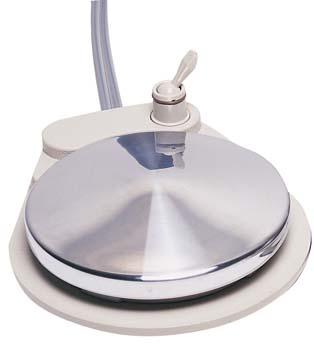In previous Practice Tips #3 we discuss the basics of dental units and the required operating unit pressure (80 psi air, 40 psi water). After a few technical calls from dentists, we thought it would be a good topic to revisit.

Insufficient Air Pressure
As discussed before, insufficient air pressure can lead to a myriad of problems. In most systems, not enough air prevents handpiece function. Air flows through the handpiece holder, which pushes down on a diaphragm to keep the handpiece from running when in the holder. *See below for a holder or go to our holders and bars for more variety. For this system to work, the main air pressure needs to be higher than your drive air, so that it keeps the drive air from forcing its way through the system. This is another reason your main pressure needs to be higher (typically 80 psi).

PHOTO: Automatic Handpiece Holder (#10-03) with Lockout Toggle
If you have a cuspidor, use the air pressure to activate the water to rinse the bowl and fill the cup. For systems with a timer, the bowl rinse or cup filler run for a time and then automatically shut off. An air reservoir typically provides the timing. When activated (via a pilot valve - #10-10), air flows into the reservoir which gradually drains as it flows into a block to turn the water on. Once the reservoir empties of air, the pressure releases on the water valve and the water then shuts off. The timer adjustment simply controls how long it takes for the air to empty from the reservoir.
Pressure Settings
Since water is denser than air, air pressure needs to be at least twice your water pressure. This guarantees the air to activate and work more efficiently. Otherwise, the greater density of water can allow it to “force” its way through the lines.
Your foot control, also, operates under standard regulated line pressure. The foot control is the first point at which your drive air pressure is stepped down. By having a solid 80 psi inlet pressure, you have plenty of range to control the outlet pressure. If the pressure came in at only 40 psi, you’d have difficulty getting a full 40 psi to your handpiece.
Your foot control may also have air operated accessories, such as a water on/off toggle. You need ample air pressure at this toggle for the same reason as you need high air pressure inside the unit. Of course, you can’t have 80 psi in the operatories unless you have enough pressure coming out of your compressor. It should be set to cycle at 90-100 psi (to support the inevitable loss of pressure as it travels).
The regulators (#05-54) in the operatories can only step the air pressure down, so you need to be sure the pressure coming into the room is in excess of 80 psi. Adequate air pressure is the first step in keeping your units running well.
We can't tell you how many calls we get that could be quickly diagnosed in-house had the doctor simply checked the gauges first. If experiencing a lack of air pressure in your delivery unit, check your gauges when experiencing issues with any dental unit component. Please give us a call at 800-331-7993 with any questions.


LEAVE A REPLY